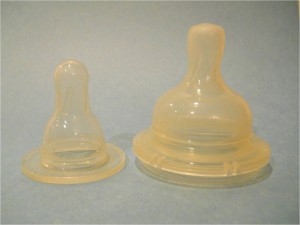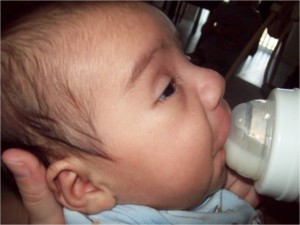This is a guest post from my esteemed colleague, Amy Peterson, BS, IBCLC. I know it will be helpful when choosing a bottle for your baby. Thank you, Amy! Photos in the post (as in all posts on this site) are copyrighted and are used with permission from Peterson & Harmer, Hale Publishing 2009.
Which bottle is most like breastfeeding? That’s the million, make that billion-dollar question! The baby bottle industry in the United States is enormous. And not surprisingly, many of the bottles claim to be most like breastfeeding to win your dollar.
Despite the claims of various companies, mothers still want to know which bottle is most like breastfeeding. The answer is as unique as how your sweet baby latches and sucks, combined with the uniqueness of how fast your milk flows from your breast. One bottle cannot be most like breastfeeding for ALL babies, because each mother and baby pair is unique.
To choose the best bottle for your baby, first it is important that you understand what’s happening during breastfeeding. Your baby’s lips widen to accept a portion of your areola. Your baby’s tongue stays over the gum ridge and cups your nipple. Your nipple reaches far back into your baby’s mouth, clear back where the hard and soft palates meet. At the beginning of a feeding, your baby latches onto your breast, which typically isn’t dripping. When you have a letdown, your baby sucks and swallows many times in a row, then naturally pauses between your letdowns. Most moms have several letdowns during a feeding, and the baby’s pauses coincide with these letdowns.
The goal of introducing a bottle to a breastfed baby is to mimic the above elements of breastfeeding to the bottle. Of course it is impossible to perfectly duplicate breastfeeding with a bottle, but we strive to control as many of these details as possible.
There are two things to consider when choosing a bottle: shape and flow. These are of equal importance. Finding the slowest flow on the market will not protect breastfeeding if the latch is wrong. Likewise, finding a great shape will not protect breastfeeding if your baby chokes and sputters or works too hard.

Left nipple has gradual flaring. Right nipple has abrupt transition
First, to select a nipple, look at the nipple shape rather than reading the claims on the box. The nipple shape needs to gradually flare from nipple tip to base. This shape allows the nipple tip to reach far into your baby’s mouth, and then your baby’s tongue can cup the nipple length. The gradual widening encourages your baby’s lips to widen and rest on the base of the nipple, mimicking your areola.

Lips widening nicely on a nipple that gradually flares
Instinct, and packaging, may tell us that a wide nipple shape is most like the breast and will encourage a wide latch. This is not true for many babies. If the nipple shape has an abrupt transition between the nipple tip and base, often the baby’s mouth will close when s/he feels the nipple “stop.” When this happens, the baby looks like s/he is sucking on a straw, which is very different than breastfeeding!

Baby’s lips are pursed and looks like she is sucking from a straw.
There is an exception to choosing nipple shape. If a baby has a tongue tie that isn’t revised, the baby may latch better on a long nipple while using a closed mouth feeding position. This will help the baby’s tongue work more effectively until the tongue tie is revised. After revision, a new nipple will need to be chosen that allows the baby’s mouth to widen.
Second, pay attention to nipple flow. There is no industry standard for slow flow nipples; any nipple can be labeled slow regardless of how fast they flow. Nonetheless, make sure the package says “slow” or “level/stage1.” It is also important to use the bottle nipple with the correct brand of bottle; mixing brands can hinder flow.
Did you know it’s a MYTH that you can test how fast a bottle flows by turning it upside down? Turning a bottle upside down only measures dripping, which is different than flow.**(See note below.) Dripping is still important. Remember that your baby latches onto your breast when it’s not dripping. Do this with the bottle, too, holding the bottle at an angle where the milk is not in the nipple when your baby starts sucking. Tip it up after your baby has a nice latch and begins sucking.
To judge flow, you’ll need to pay attention to how your baby swallows. Your baby’s swallowing rhythm should be similar to the swallowing rhythm during breastfeeding. If your baby looks worried, pulls away, or sputters, the nipple is too fast. If your baby has to suck several times before swallowing, or takes more than 10-15 minutes to feed, the nipple is too slow.
So remember, don’t fall for packaging claims. Instead, watch your baby to determine the best choice for him/her. By selecting a nipple shape and flow that allows your baby to latch and swallow in a manner similar to breastfeeding, you can protect your breastfeeding relationship.
**Note: Amy and co-author Mindy have tested and ranked bottle nipples according to flow. This information is found in Appendix C of Balancing Breast and Bottle: Reaching Your Breastfeeding Goals. There is also helpful information on their website and in their book, Balancing Breast and Bottle: Reaching Your Breastfeeding Goals. Your lactation consultant (IBCLC) may also have this information on hand to help you choose the best bottle flow for your baby.
See also: Bottle Feeding: Your Baby Sets the Pace
